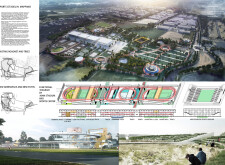5 key facts about this project
**Overview of the Sports Citadel**
Located in Mappano, the Sports Citadel comprises an integrated sports complex designed to accommodate a diverse range of athletic activities while fostering community engagement and environmental stewardship. The facility is intended to serve both elite athletes and local residents, with a focus on inclusivity and accessibility. The overall design prioritizes the connection between urban activities and existing natural elements, such as mature trees and surrounding roadways.
**Spatial Strategy**
The spatial organization of the Sports Citadel is anchored by a main stadium, which functions as a central hub for various sporting events and community gatherings. Adjacent to the stadium, a sports center provides comprehensive training facilities, including courts for volleyball and basketball, a gymnasium, and swimming pools. The layout is intentionally designed to enhance movement and interaction among users, with pedestrian pathways interconnecting the different facilities. Additional outdoor spaces feature a running track, climbing walls, and multipurpose sports grounds, which serve both athletic and recreational purposes.
**Material Selection and Sustainability**
Material choices for the Sports Citadel reflect a commitment to sustainability and durability. Concrete serves as a primary structural material, offering strength and adaptability. Steel elements in the framing and roofing support expansive interior spaces while promoting modern aesthetics. Glass façades are utilized to maximize natural light and create visual connections between indoor and outdoor environments. Eco-friendly finishes, including recycled composites and low-impact paints, further reduce the ecological footprint, aligning with the project's sustainability objectives.


















































